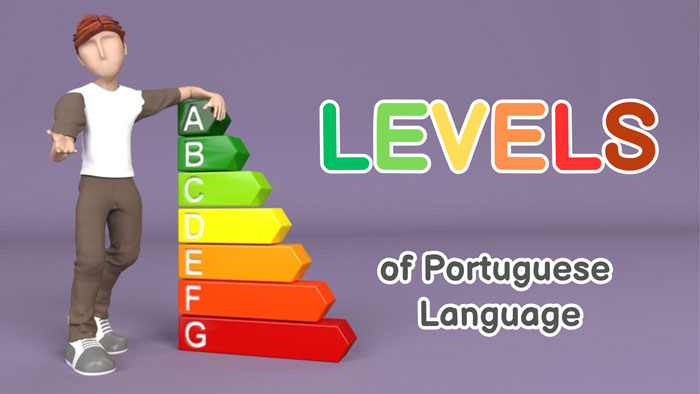Learning a new language is a gradual process that involves progressing through different levels of proficiency. In the case of Portuguese, these levels are defined by the Common European Framework of Reference for Languages (CEFR), an international system that classifies language skills into six main levels: A1, A2, B1, B2, C1, and C2.
If you are learning Portuguese, it is important to know your current level so that you can choose the most suitable study materials and set realistic goals for your progress. In this article, we will explore the different Portuguese proficiency levels, how to assess your level, and some tips to advance quickly.
Portuguese Levels According to the CEFR
The Common European Framework of Reference for Languages (CEFR) divides language learning into three broad categories:
A (Basic): A1 and A2
B (Intermediate): B1 and B2
C (Advanced): C1 and C2
Now, let’s analyze each of these levels in detail and see what is expected from a speaker at each stage.
A1 – Beginner
The A1 level corresponds to the first contact with the Portuguese language. At this stage, the learner can communicate in a very simple way, using basic words and phrases for everyday situations.
What can you do at this level?
- Introduce yourself and say your name, age, and nationality
- Ask and answer basic personal information
- Use simple sentences to describe your daily routine
- Order food in a restaurant or café, but in a very limited way
- Understand familiar words when spoken slowly and clearly
Example of a typical A1-level sentence:
“Olá, chamo-me Anna. Sou americana e moro em Lisboa. Tenho 25 anos.” (Hello, my name is Ana. I am Brazilian and live in Lisbon. I am 25 years old.)
If you are at this level, you still have difficulty understanding fast conversations and cannot form longer sentences without hesitation.
A2 – Elementary
The A2 level means that you can already communicate better, but still in a limited way. This is the level required to obtain Portuguese nationality through the CIPLE (Certificado Inicial de Português Língua Estrangeira) exam.
What can you do at this level?
- Participate in short conversations about common topics (e.g., work, family, shopping)
- Talk about past events using simple sentences
- Understand short and frequent phrases, such as signs or public announcements
- Ask for information in shops, public transport, or restaurants
Example of a typical A2-level sentence:
“Ontem fui ao supermercado e comprei pão, leite e queijo. Depois, fui para casa e fiz o jantar.” (Yesterday I went to the supermarket and bought bread, milk, and cheese. Then I went home and made dinner.)
If you are at this level, you still struggle to express complex ideas and maintain a long conversation without relying on your native language.
B1 – Intermediate
The B1 level is the first level where you can communicate with some fluency and independence. Many students reach this level after six months to one year of intensive study.
What can you do at this level?
- Understand simple texts about familiar topics
- Write short texts about personal experiences and opinions
- Talk about dreams, goals, and future plans
- Maintain a more natural and fluid conversation with native speakers
Example of a typical B1-level sentence:
“Gosto de viajar e já visitei vários países. No futuro, quero morar em Portugal porque gosto da cultura e do clima.” (I like to travel and have already visited several countries. In the future, I want to live in Portugal because I like the culture and climate.)
If you are at this level, you already understand most everyday conversations, but you still have difficulty with idiomatic expressions and more technical vocabulary.
B2 – Upper-Intermediate
The B2 level means that you already have enough fluency to live and work in Portuguese. Many universities and companies in Portugal require this level for the admission of foreign students and employees.
What can you do at this level?
- Understand texts and news about more abstract topics
- Express opinions and argue in a structured way
- Participate in spontaneous conversations without difficulties
- Watch movies and TV series in Portuguese with little difficulty
Example of a typical B2-level sentence:
“Acho que aprender línguas é essencial nos dias de hoje. Quando falamos mais do que uma língua, conseguimos oportunidades melhores no mercado de trabalho.” (I think learning languages is essential nowadays. When we speak more than one language, we get better opportunities in the job market.)
If you are at this level, you may still struggle with regional accents or very technical discussions, but you can already communicate without major problems.
C1 – Advanced
The C1 level indicates almost total fluency. At this stage, you can already speak Portuguese naturally and confidently, even on complex topics.
What can you do at this level?
- Use idiomatic expressions and sophisticated vocabulary
- Write long and structured texts (e.g., essays, reports)
- Understand most TV programs and podcasts
- Participate in debates on politics, culture, and society
Example of a typical C1-level sentence:
“Embora muitas pessoas considerem o português uma língua difícil, acredito que a sua riqueza linguística e cultural compensa o esforço necessário para aprendê-la.” (Although many people consider Portuguese a difficult language, I believe its linguistic and cultural richness makes the effort to learn it worthwhile.)
If you are at this level, you can already work and study in Portuguese without difficulties, but you may still need to refine small language nuances.
C2 – Proficient
The C2 level is the level of an almost native speaker. Few people reach this level without many years of practice and immersion.
What can you do at this level?
- Understand any text or speech, regardless of the topic
- Adapt your speech to different contexts and registers
- Understand irony, sarcasm, and wordplay
Example of a typical C2-level sentence:
“A riqueza da língua portuguesa reside na sua diversidade fonética, morfológica e lexical, o que a torna um idioma fascinante para quem a estuda profundamente.” (The richness of the Portuguese language lies in its phonetic, morphological, and lexical diversity, making it a fascinating language for those who study it in depth.)
How to Know Your Portuguese Level
If you want to determine your Portuguese level, you can:
- Take an online placement test
- Talk to a teacher and request an assessment
- Take an official exam, such as CIPLE (A2), DEPLE (B1), DIPLE (B2), DAPLE (C1), or DUPLE (C2)
Without a doubt, the fastest and most effective way is to take a placement test with a teacher, as most online tests are neither accurate nor reliable, and taking an official exam requires time and has higher costs.
Conclusion
Regardless of your current level, keep practicing. The key to progress is consistency and exposure to the language.

